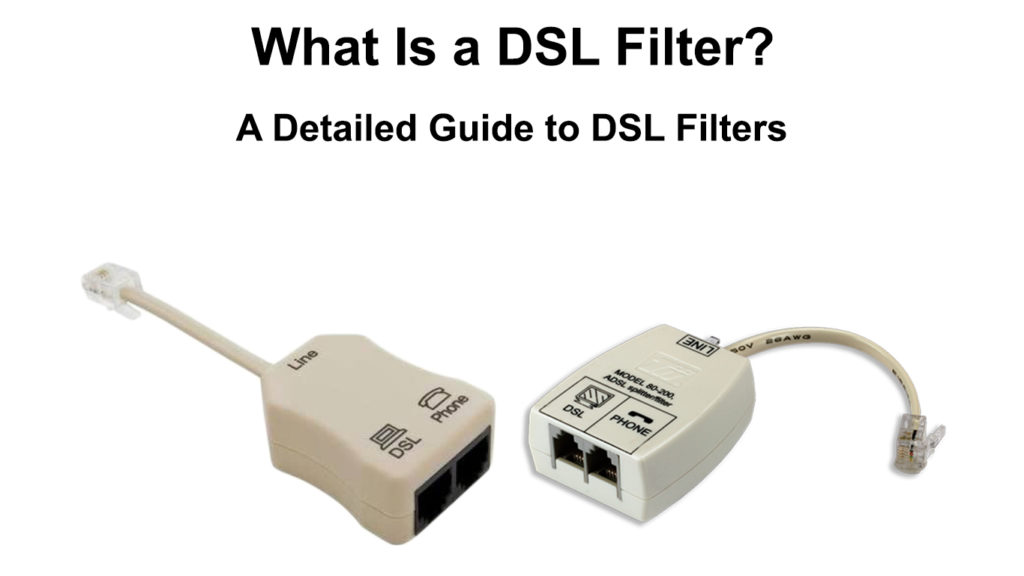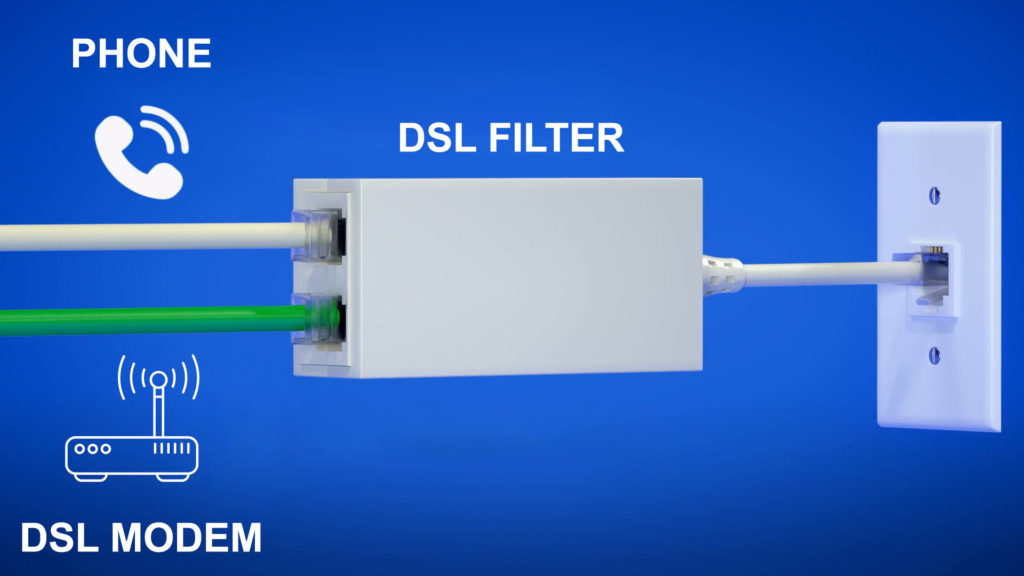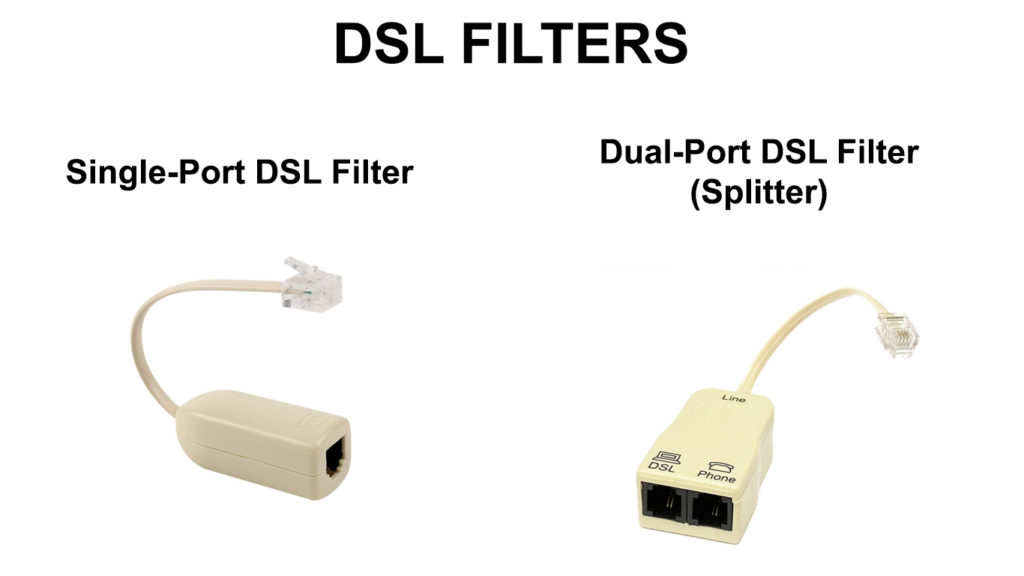Internet connections come from the ISPs to our homes through various channels. One of these channels is a Digital Subscriber Line (DSL), where the provider uses phone lines to transmit digital and phone signals simultaneously. The technology is not too sophisticated, and it allows sharing of infrastructure to provide more than one service to consumers.
Most DSL users who have internet and phone connectivity have a dongle attached to the phone line known as a DSL filter.
Keep reading as we figure out what this gadget is and if it is essential in DSL connections. While at it, we will also look at everything concerning DSL connections, such as ADSL.

CONTENTS
What Is a DSL Connection?
To effectively understand what a DSL filter is, we must first understand how a DSL connection works.
A DSL connection uses the same copper cables used to transmit phone signals and digital data. The simultaneous transmission is possible since phone signals only utilize a small portion of the copper cables’ bandwidth, leaving a large portion idle. Service providers decided to use the other available bandwidth for transmitting digital data signals.
The connection is effective since it only requires a quality phone line to transmit data. It does not matter whether the phone line carries phone signals; it will transmit internet data. All you need is a DSL modem that can convert the signal into a compatible signal for your home’s internet devices.
DSL connections are easier to install since your home probably already has a phone line running through the walls.
The connection is faster, especially when compared to dial-up internet, which does not let you use the internet and phone signals simultaneously.
DSL lines transmit the internet connection on a higher frequency than the phone signal, thus making it easier to transmit both signals simultaneously.
However, despite all these advantages, DSL connections came with some drawbacks. The major drawback is that there can be signal interference once these phone and data signals get to the home.
The high-frequency internet signals could leak into the low-frequency phone signals, thus resulting in noise in the phone line.
Even though a DSL connection is a broadband connection, it is not the best for bandwidth-consuming activities such as online gaming or heavy streaming.
DSL Internet Connection Explained
What Is a DSL Filter?
To overcome signals leaking and thus prevent noise on the phone line, the inventor Vic Charlton made a low-pass filter that could separate low-frequency signals from high-frequency signals.
The filter only allows low-frequency signals to go to the phone and prevents high-frequency signals from going to the same phone. That is why it is essentially known as a filter.
You can install a DSL filter in one of two ways.
It can be installed via the splitter method, where a DSL filter is installed on one end of a split cable line coming into the home or business. The line with the filter then runs to every point where analog devices will need an analog signal to operate appropriately. The other end of the split cable runs to the DSL modem, making the connection less cumbersome.
Recommended reading:
- What Does Google Wi-Fi Do? (Ultimate Guide to Google Wi-Fi)
- Verizon Cellular Data Not Working (Ways to Fix It)
- Spectrum Transfer Service to Another Person (How to Do It?)
It is easier to split the cables if the wiring in your home was done using Cat 3, Cat 4, or Cat 5 cables since they are made up of copper wires arranged in twisted pairs. Therefore, if one pair is free, you can connect a DSL filter to it at the Telephone Network Interface box (TNI). Then run a cable from the filter to all-analog signal devices like telephones and fax machines.
Also, commercially available filters allow you to easily separate these signals by connecting them to the DSL line at the wall jack. The filters separate one line of the pairs to have an unfiltered connection to the DSL line, while the other line is filtered.

An alternative method is to install a DSL filter at every jack that will connect to an analog device and then connect the analog device to the DSL filter. Such a set-up requires more than one filter; hence it is less preferred.
Typically, the only jack that can be without a filter is the one that connects to the DSL modem since it requires high-frequency signals to transmit an internet connection.
It is important to note that Cat 3 cables have four parallel wires, so crosstalk easily happens, thus degrading the DSL signal and, in turn, causing connectivity issues for the phones and internet connections. Crosstalk is when signals from one line negatively affect the signals on the other line. Therefore, it is preferable to use Cat 4 and 5 cables.
Also, DSL filters are passive devices meaning they do not require power to function. To use the filters, plug them into a wall jack and plug the phone line into the filter, and you are ready to go.
However, high-quality DSL filters, which are more expensive, have additional components like transistors, capacitors, and resistors for smoother filtering. These additional components require power – they are active filters.
How to Install a DSL Filter
What Impact Does a DSL Filter Have on Your Connection?
A DSL filter can improve the quality of your internet and phone connection. It does this by ensuring the lower-end signal ranges of the DSL internet do not affect the higher-end signal ranges of your phone line.
It also ensures that your phone line’s higher-end signals do not impact the lower-end signals of your DSL connection.
Without a DSL filter, features like caller ID might not function properly, and your internet connectivity might be adversely affected.
Are DSL and ADSL Filters the Same Things?
When DSL was implemented, it did not take long before improvements were made to the technology. For instance, DSL connections used a roughly similar bandwidth to send information to the internet (upstream) and receive data (downstream).
Service providers considered this unnecessary since they genuinely believed that users downloaded more information from the internet than they uploaded. In other terms, more bandwidth was needed by users for downloading data than it was required for uploading data. Hence the invention of ADSL, which stands for Asymmetric Digital Subscriber Line.
ADSL is divided so that it uses more bandwidth for downloading data than it uses for uploading. An ADSL connection uses approximately 1Mbps for uploading data and 8 Mbps for downloading data.
Therefore, ADSL filters regulate ADSL signals to not interfere with the phone line on ADSL connections.
Notably, ADSL has more versions that are all named regarding the value of the upstream and downstream bandwidth they support.
For example, ADSL2+ supports 1.4Mbps upstream and 24Mbps downstream.
xDSL Technology
There are various DSL versions currently available in the market. They are all cumulatively referred to as xDSL, where x stands for the different letters that identify the DSL version.
The DSL technologies are all named according to the data rate transfer they support in upstream and downstream directions.
More examples apart from ADSL and ADSL 2+ are:
VDSL – Very-High-bit-rate digital subscriber line. It can support up to 52Mbps up and 16Mbpps down.
HDSL – High Digital Subscriber Line. It supports a 1544kbps up and down over a single pair (HDSL2) or a double pair (HDSL4)
How to Troubleshoot A DSL Filter
Sometimes you might suspect that your DSL filter is causing problems with your connection rather than helping you solve them.
A common indication of a malfunctioning filter is that the phone will produce a lot of static while you are using it.
You can check if your filter is faulty by:
- Disconnecting your DSL filter from the wall jack
- Disconnect all other devices on your DSL line
- Then directly plug your phone onto the DSL line
- Make a test call and listen if the phone is still making high-pitched sounds or producing static sounds.
- If the phone is not making any weirder noises, the problem is with the filter.
- If the phone keeps making noises, it could be faulty; therefore, consult a qualified technician to look at it.
Final Thoughts
As we have seen, there are single-port DSL filters that should only connect to the phone or analog device. They cannot be connected to the DSL modem as they would result in connectivity issues that you can avoid. There are also dual-port DSL filters meant to connect to the DSL modem and phone line after connecting to the wall jack. These are easier to install but should not be used if you still do not understand what DSL filters are and what they do.

Ensure you consult your DSL service provider to determine what type of DSL filter you should use, i.e., the splitter or the non-splitter kind. If you have the DSL splitter, you do not need any more DSL filters in your home or office.
Also, remember that the further you are from your DSL service provider, the more likely you are to receive an unreliable signal, as DSL lines need to be as close as possible to provide a reliable signal.

Hey, I’m Jeremy Clifford. I hold a bachelor’s degree in information systems, and I’m a certified network specialist. I worked for several internet providers in LA, San Francisco, Sacramento, and Seattle over the past 21 years.
I worked as a customer service operator, field technician, network engineer, and network specialist. During my career in networking, I’ve come across numerous modems, gateways, routers, and other networking hardware. I’ve installed network equipment, fixed it, designed and administrated networks, etc.
Networking is my passion, and I’m eager to share everything I know with you. On this website, you can read my modem and router reviews, as well as various how-to guides designed to help you solve your network problems. I want to liberate you from the fear that most users feel when they have to deal with modem and router settings.
My favorite free-time activities are gaming, movie-watching, and cooking. I also enjoy fishing, although I’m not good at it. What I’m good at is annoying David when we are fishing together. Apparently, you’re not supposed to talk or laugh while fishing – it scares the fishes.
